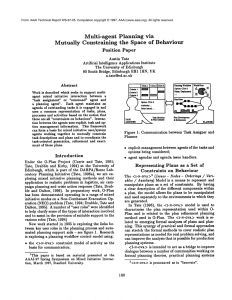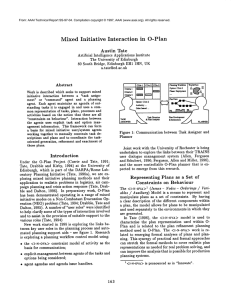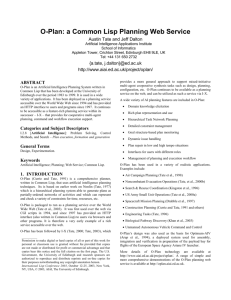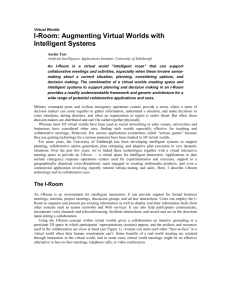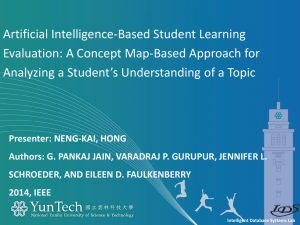2011-02-18-Granada-Tate - Artificial Intelligence Applications
advertisement
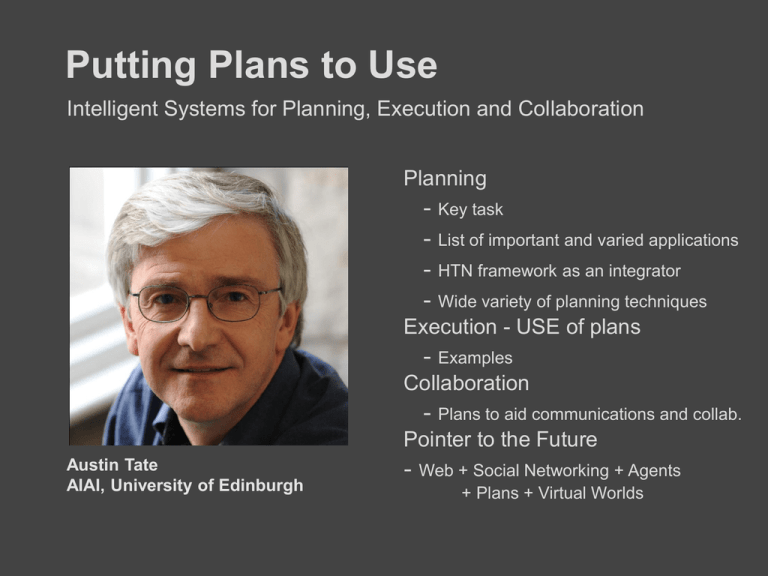
Putting Plans to Use Intelligent Systems for Planning, Execution and Collaboration Planning - Key task - List of important and varied applications - HTN framework as an integrator - Wide variety of planning techniques Execution - USE of plans - Examples Collaboration - Plans to aid communications and collab. Pointer to the Future Austin Tate AIAI, University of Edinburgh - Web + Social Networking + Agents + Plans + Virtual Worlds Suggested Reading O-Plan and its Applications Tate, A. and Dalton, J. (2003) O-Plan: a Common Lisp Planning Web Service, invited paper, in Proceedings of the International Lisp Conference 2003, October 12-25, 2003, New York, NY, USA, October 12-15, 2003. http://www.aiai.ed.ac.uk/project/ix/documents/2000/2000-sges-tate-intelligible-planning.pdf I-X/I-Plan and its Integration Approach Tate, A. (2000) Intelligible AI Planning, in Research and Development in Intelligent Systems XVII, Proceedings of ES2000, The Twentieth British Computer Society Special Group on Expert Systems International Conference on Knowledge Based Systems and Applied Artificial Intelligence, pp. 3-16, Cambridge, UK, December 2000, Springer. http://www.aiai.ed.ac.uk/project/ix/documents/2003/2003-luc-tate-oplan-web.pdf I-Rooms Tate, A. (2010) I-Room: Integrating Intelligent Agents and Virtual Worlds, X10 Workshop on Extensible Virtual Worlds (http://vw.ddns.uark.edu/X10). Organized by the IBM Academy of Technology and the University of Arkansas. Second Life, March 29-30, 2010. http://www.aiai.ed.ac.uk/project/ix/documents/2010/2010-xvw-tate-iroom.pdf Helpful Environment Tate, A. (2006) The Helpful Environment: Geographically Dispersed Intelligent Agents That Collaborate, Special Issue on "The Future of AI", IEEE Intelligent Systems, May-June 2006, Vol. 27, No. 3, pp 57-61. IEEE Computer Society. http://www.aiai.ed.ac.uk/project/ix/documents/2006/2006-ieee-is-tate-helpful-env-as-published.pdf AI Planning • Practical AI Planners • Edinburgh Planners – Nonlin – O-Plan – Optimum-AIV – I-X/I-Plan • Planning++ Edinburgh AI Planners in Productive Use http://www.aiai.ed.ac.uk/project/plan/ Nonlin (1974-1977) • • • • • • • • Hierarchical Task Network Planner Partial Order Planner Plan Space Planner (vs. Application State Space) Goal structure-based plan development - considers alternative “approaches” based on plan rationale QA/ “Modal Truth Criterion” Condition Achievement Condition “Types” to limit search “Compute Conditions” for links to external data and systems (attached procedures) Time and Resource Constraint checks • Nonlin core is basis for text book descriptions of HTN Planning O-Plan (1983-1999) Features • • • • • • • • • Domain knowledge elicitation and modelling tools Rich plan representation and use Hierarchical Task Network Planning Detailed constraint management Goal structure-based plan monitoring Dynamic issue handling Plan repair in low and high tempo situations Interfaces for users with different roles Management of planning and execution workflow Features Typical of a number of Practical AI Planning Planners O-Plan (1983-1999) Lineage O-Plan Unix Sys Admin Aid O-Plan Emergency Response Task Description, Planning and Workflow Aids Practical Applications of AI Planning – O-Plan Applications O-Plan has been used in a variety of realistic applications: • • • • • • • • Noncombatant Evacuation Operations (Tate, et al., 2000b) Search & Rescue Coordination (Kingston et al., 1996) US Army Hostage Rescue (Tate et al., 2000a) Spacecraft Mission Planning (Drabble et al., 1997) Construction Planning (Currie and Tate, 1991 and others) Engineering Tasks (Tate, 1997) Biological Pathway Discovery (Khan et al., 2003) Unmanned Autonomous Vehicle Command and Control • O-Plan’s design was also used as the basis for Optimum-AIV (Arup et al., 1994), a deployed system used for assembly, integration and verification in preparation of the payload bay for flights of the European Space Agency Ariane IV launcher. Optimum-AIV Optimum-AIV (1992-4) Features • • • • • • • Rich plan representation and use Hierarchical Task Network Planning Detailed constraint management Planner and User rationale recorded Dynamic issue handling Plan repair using test failure recovery plans Integration with ESA’s Artemis Project Management System Some Practical Applications of AI Planning • • • • Nonlin electricity generation turbine overhaul Deviser Voyager mission planning demonstration SIPE – a planner that can organise a …. brewery Optimum-AIV – Integrating technologies – Integrating with other IT systems • O-Plan – a wide range of diverse applications • Bridge Baron • Deep Space 1 – to boldly go… Deep Space 1 – 1998-2001 http://nmp.jpl.nasa.gov/ds1/ DS 1 – Comet Borrelly http://nmp.jpl.nasa.gov/ds1/ DS1 Remote Agent Approach • Constraint-based planning and scheduling – supports goal achievement, resource constraints, deadlines, concurrency • Robust multi-threaded execution – supports reliability, concurrency, deadlines • Model-based fault diagnosis and reconfiguration – supports limited observability, reliability, concurrency • Real-time control and monitoring Common Themes in Practical Applications of AI Planning • Outer “human-relatable” approach (e.g. HTN) • Underlying rich time and resource constraint handling • Integration with plan execution • Model-based simulation and monitoring • Rich knowledge modelling languages and interfaces Planning Research Areas & Techniques – Domain Modelling – Domain Description – Domain Analysis – – – – – – – – – HTN, SIPE PDDL, NIST PSL TIMS Search Methods Heuristics, A* Graph Planning Algthms GraphPlan Partial-Order Planning Nonlin, UCPOP Hierarchical Planning NOAH, Nonlin, O-Plan Refinement Planning Kambhampati Opportunistic Search OPM Constraint Satisfaction CSP, OR, TMMS Optimisation Methods NN, GA, Ant Colony Opt. Issue/Flaw Handling O-Plan – Plan Analysis NOAH, Critics – Plan Simulation QinetiQ – Plan Qualitative Mdling Excalibur – Plan Repair – Re-planning – Plan Monitoring O-Plan O-Plan O-Plan, IPEM – Plan Generalisation Macrops, EBL – Case-Based Planning CHEF, PRODIGY – Plan Learning SOAR, PRODIGY – User Interfaces – Plan Advice – Mixed-Initiative Plans SIPE, O-Plan SRI/Myers TRIPS/TRAINS – Planning Web Services O-Plan, SHOP2 – Plan Sharing & CommsI-X, <I-N-C-A> – NL Generation … – Dialogue Management … Planning Research Areas & Techniques – Domain Modelling – Domain Description – Domain Analysis – – – – – – – – – HTN, SIPE PDDL, NIST PSL TIMS Search Methods Heuristics, A* Graph Planning Algthms GraphPlan Partial-Order Planning Nonlin, UCPOP Hierarchical Planning NOAH, Nonlin, O-Plan Refinement Planning Kambhampati Opportunistic Search OPM Constraint Satisfaction CSP, OR, TMMS Optimisation Methods NN, GA, Ant Colony Opt. Issue/Flaw Handling O-Plan – Plan Analysis NOAH, Critics – Plan Simulation QinetiQ – Plan Qualitative Mdling Excalibur – Plan Repair – Re-planning – Plan Monitoring O-Plan O-Plan O-Plan, IPEM – Plan Generalisation Macrops, EBL – Case-Based Planning CHEF, PRODIGY – Plan Learning SOAR, PRODIGY – User Interfaces – Plan Advice – Mixed-Initiative Plans SIPE, O-Plan SRI/Myers TRIPS/TRAINS – Planning Web Services O-Plan, SHOP2 – Plan Sharing & CommsI-X, <I-N-C-A> – NL Generation … – Dialogue Management … Deals with whole life cycle of plans A More Collaborative Planning Framework • Human relatable and presentable objectives, issues, sense-making, advice, multiple options, argumentation, discussions and outline plans for higher levels • Detailed planners, search engines, constraint solvers, analyzers and simulators act in this framework in an understandable way to provide feasibility checks, detailed constraints and guidance • Sharing of processes and information about process products between humans and systems • Current status, context and environment sensitivity • Links between informal/unstructured planning, more structured planning and methods for optimisation I-X/I-Plan (2000- ) • Shared, intelligible, easily communicated and extendible conceptual model for objectives, processes, standard operating procedures and plans: – I Issues – N Nodes/Activities – C Constraints – A Annotations • Communication of dynamic status and presence for agents, and reports about their collaborative processes and process products • Context sensitive presentation of options for action • Intelligent activity planning, execution, monitoring, replanning and plan repair via I-Plan and I-P2 (I-X Process Panels) <I-N-C-A> Framework • Common conceptual basis for sharing information on processes and process products • Shared, intelligible to humans and machines, easily communicated, formal or informal and extendible • Set of restrictions on things of interest: • – I Issues e.g. what to do? How to do it? – N Nodes e.g. include activities or product parts – C Constraints e.g. state, time, spatial, resource, … – A Annotations e.g. rationale, provenance, reports, … Shared collaborative processes to manipulate these: – Issue-based sense-making (e.g. gIBIS, 7 issue types) – Activity Planning and Execution (e.g. mixed-initiative planning) – Constraint Satisfaction (e.g. AI and OR methods, simulation) – Note making, rationale capture, logging, reporting, etc. • Maintain state of current status, models and knowledge • I-X Process Panels (I-P2) use representation and reasoning together with state to present current, context sensitive, options for action Mixed-initiative collaboration model of “mutually constraining things” I-P2 aim is a Planning, Workflow and Task Messaging “Catch All” • Can take ANY requirement to: – Handle an issue – Perform an activity – Respect a constraint – Note an annotation • Deals with these via: – Manual activity – Internal capabilities – External capabilities – Reroute or delegate to other panels or agents – Plan and execute a composite of these capabilities (I-Plan) • Receives reports and interprets them to: – Understand current status of issues, activities and constraints – Understand current world state, especially status of process products – Help user control the situation • Copes with partial knowledge of processes and organisations I-X Process Panel and Tools Domain Editor Process Panel Messenger Map Tool I-Plan I-X for Emergency Response Central Authorities Collaboration and Communication Command Centre Emergency Responders Isolated Personnel I-Room: a Virtual Space for Intelligent Interaction Operations Centres, Brainstorming Spaces, Team Meeting Rooms, Training and Review Areas I-Room Introduction • I-Room provides a 3D virtual space with multiple work zones, designed for collaborative and brain storming style meetings • I-Rooms are used in the I-X research on intelligent collaborative and task support environments • The main feature of the I-Room is the link up with external web services, collaboration systems and intelligent systems aids I-Room Applications • • • • • • • • • Virtual collaboration centre Business teleconferencing Team Meetings for project and product reviews Product Help Desks Design to Product - product lifecycle support Environment, building and plant monitoring Health and safety at work, disability awareness Intelligent tutors, guides and greeters Active demonstration pavilions I-Room Integration • The I-Room 3D virtual space is linked to a social networking and community knowledge management web portal in OpenVCE.net • Recent experimental use of the I-Room and OpenVCE for the "Whole of Society Crises Response" (WoSCR) community in the conduct of emergency response and crisis management • This is intended as a contribution to the wider notions of "The Helpful Environment" I-Room: Mixed-initiative Collaboration Truly distributed mixed initiative collaboration and task support is the focus of the I-Room, allowing for the following tasks: • • • • • • • • situation monitoring sense-making analysis and simulation planning option analysis briefing decision making responsive enactment Briefing and Decision Making Planning, Evaluation Option Argumentation Central Meeting Area Sensing and Situation Analysis Acting, Reacting and Communication Helpful Environment The creation and use of task-centric virtual organizations involving people, government and non-governmental organizations, automated systems, grid and web services working alongside intelligent robotic, vehicle, building and environmental systems to respond to very dynamic events on scales from local to global. • • • • • • • • Multi-level emergency response and aid systems Personal, vehicle, home, organization, district, regional, national, international Backbone for progressively more comprehensive aid and emergency response Also used for aid-orientated commercial services Robust, secure, resilient, distributed system of systems Advanced knowledge and collaboration technologies Low cost, pervasive sensor grids, computing and communications Changes in codes, regulations, training and practices Tate, A. (2006) The Helpful Environment: Geographically Dispersed Intelligent Agents That Collaborate, Special Issue On "The Future of AI", IEEE Intelligent Systems, May-June 2006, Vol. 27, No. 3, pp 57-61. IEEE Computer Society. Suggested Reading O-Plan and its Applications Tate, A. and Dalton, J. (2003) O-Plan: a Common Lisp Planning Web Service, invited paper, in Proceedings of the International Lisp Conference 2003, October 12-25, 2003, New York, NY, USA, October 12-15, 2003. http://www.aiai.ed.ac.uk/project/ix/documents/2000/2000-sges-tate-intelligible-planning.pdf I-X/I-Plan and its Integration Approach Tate, A. (2000) Intelligible AI Planning, in Research and Development in Intelligent Systems XVII, Proceedings of ES2000, The Twentieth British Computer Society Special Group on Expert Systems International Conference on Knowledge Based Systems and Applied Artificial Intelligence, pp. 3-16, Cambridge, UK, December 2000, Springer. http://www.aiai.ed.ac.uk/project/ix/documents/2003/2003-luc-tate-oplan-web.pdf I-Rooms Tate, A. (2010) I-Room: Integrating Intelligent Agents and Virtual Worlds, X10 Workshop on Extensible Virtual Worlds (http://vw.ddns.uark.edu/X10). Organized by the IBM Academy of Technology and the University of Arkansas. Second Life, March 29-30, 2010. http://www.aiai.ed.ac.uk/project/ix/documents/2010/2010-xvw-tate-iroom.pdf Helpful Environment Tate, A. (2006) The Helpful Environment: Geographically Dispersed Intelligent Agents That Collaborate, Special Issue on "The Future of AI", IEEE Intelligent Systems, May-June 2006, Vol. 27, No. 3, pp 57-61. IEEE Computer Society. http://www.aiai.ed.ac.uk/project/ix/documents/2006/2006-ieee-is-tate-helpful-env-as-published.pdf I-X – Intelligent Systems Technology I-Room – a Virtual Space for Intelligent Interaction OpenVCE – Virtual Collaboration Environment The Helpful Environment Web + Social Networking + Agents + Plans + Virtual Worlds http://i-x.info http://openvce.net http://openvce.net/i-room http://openvce.net/helpful-environment Extra Slides • • • • Deep Space 1 Extra Slides and Papers I-X Extra Slides I-Room Extra Slides Helpful Environment Extra Slides DS1 Domain Requirements Achieve diverse goals on real spacecraft • High Reliability – single point failures – multiple sequential failures • Tight resource constraints – resource contention – conflicting goals • Hard-time deadlines • Limited Observability • Concurrent Activity DS1 – Flight Experiments 17th – 21st May 1999 • RAX was activated and controlled the spacecraft autonomously. Some issues and alarms did arise: – Divergence of model predicted values of state of Ion Propulsion System (IPS) and observed values – due to infrequency of real monitor updates. – EXEC deadlocked in use. Problem diagnosed and fix designed by not uploaded to DS1 for fears of safety of flight systems. • Condition had not appeared in thousands of ground tests indicating needs for formal verification methods for this type of safety/mission critical software. • Following other experiments, RAX was deemed to have achieved its aims and objectives. DS1 Literature • Deep Space 1 Papers • • • Ghallab, M., Nau, D. and Traverso, P., Automated Planning – Theory and Practice, chapter 19,. Elsevier/Morgan Kaufmann, 2004. Bernard, D.E., Dorais, G.A., Fry, C., Gamble Jr., E.B., Kanfesky, B., Kurien, J., Millar, W., Muscettola, N., Nayak, P.P., Pell, B., Rajan, K., Rouquette, N., Smith, B., and Williams, B.C. Design of the Remote Agent experiment for spacecraft autonomy. Procs. of the IEEEAerospace Conf., Snowmass, CO, 1998. http://nmp.jpl.nasa.gov/ds1/papers.html • Other Practical Planners • • Ghallab, M., Nau, D. and Traverso, P., Automated Planning – Theory and Practice, chapter 22 and 23. Elsevier/Morgan Kaufmann, 2004 Tate, A. and Dalton, J. (2003) O-Plan: a Common Lisp Planning Web Service, invited paper, in Proceedings of the International Lisp Conference 2003, October 12-25, 2003, New York, NY, USA, October 12-15, 2003. • http://www.aiai.ed.ac.uk/project/ix/documents/2003/2003-luc-tate-oplan-web.doc I-X Approach • The I-X approach involves the use of shared models for task-directed communication between human and computer agents • I-X system or agent has two cycles: – Handle Issues – Manage Domain Constraints • I-X system or agent carries out a (perhaps dynamically determined) process which leads to the production of (one or more alternative options for) a “product” • I-X system or agent views the synthesised artefact as being represented by a set of constraints on the space of all possible artefacts in the application domain Helpful Environment Related Projects • CoAKTinG (Collaborative Advanced Knowledge Technologies in the Grid) – also I-Rescue (Kobe), AKT e-Response and OpenKnowledge – – • CoSAR-TS (Coalition Search and Rescue – Task Support) – • Use of OWL ontologies and OWL-S described services to describe components FireGrid – • Use of OWL ontologies and OWL-S described services to describe components Co-OPR (Collaborative Operations for Personnel Recovery) – • Linking issue handling, argumentation, process support, instance messaging and agent presence notification Range of natural, industrial and other emergency scenarios to establish a cross-disciplinary collaborative community to pursue fundamental research for developing faster than real time emergency response systems using the “Grid” e-Response – – Creation and use of task-centric virtual organizations to respond to highly dynamic events on scales from local to global Flood, metropolitan emergency and industrial accident scenarios Helpful Environment "The Helpful Environment" vision is of a future in which ubiquitous computing, sensor grids and networked systems combine to help the individuals, families, businesses, organizations, the public at large, regions and countries to be self supportive and mutually helpful with specialised resources for their daily lives, for help and assistance in emergencies. The vision, some international programmes which contribute to it, some of the organisations that are pursuing this vision and some of the Edinburgh projects and research that will we hope will help make it a reality is described in this paper: Tate, A. (2006) The Helpful Environment: Geographically Dispersed Intelligent Agents That Collaborate, Special Issue On "The Future of AI", IEEE Intelligent Systems, May-June 2006, Vol. 27, No. 3, pp 57-61. IEEE Computer Society. People & Organizations Environment for Multiagent and Intelligent Systems, AI Magazine, Spring, 2001. Adapted from H. Kitano and S. Tadokoro, RoboCup Rescue A Grand Challenge RoboRescue 50 Year Programme Systems AIAI Planning Group Aims AIAI, University of Edinburgh Intelligent Systems - Planning and Activity Management Explores representations and reasoning mechanisms for inter-agent activity support. The agents may be people or computer systems working in a coordinated fashion. The group explores and develops generic approaches by engaging in specific applied studies. Applications include crisis action planning, command and control, space systems, manufacturing, logistics, construction, procedural assistance, help desks, emergency response, etc. Our long term aim is the creation and use of task-centric virtual organisations involving people, government and non-governmental organisations, automated systems, grid and web services working alongside intelligent robotic, vehicle, building and environmental systems to respond to very dynamic events on scales from local to global. http://www.aiai.ed.ac.uk/project/plan/
